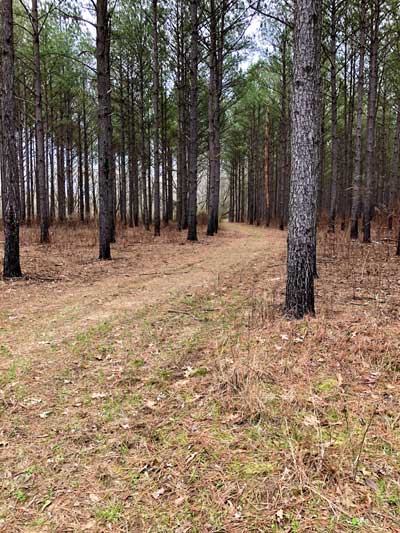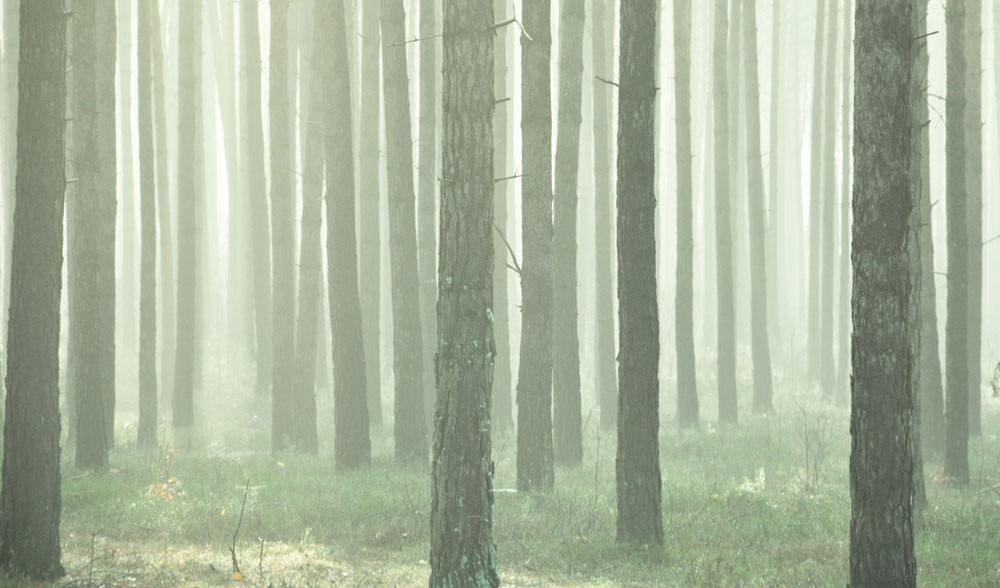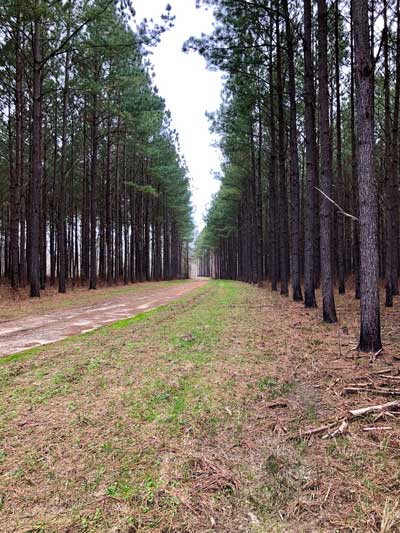provided by Mossy Oak Properties
If you live in the Deep South, chances are that pine trees are as much a part of your view as grass or blue skies. The Deep South has been called the “wood basket,” because of its established and integral timber industry. This timber industry creates hundreds of thousands of jobs and pumps billions of dollars into the economy each year.
Until the last century, the landscape of much of the Deep South - especially that in the Lower Coastal Plain - was dominated by the venerable longleaf pine. As the timber industry picked up steam and the "cut out and get out" management style was replaced with a more sustainable mindset, companies opted for the faster-growing loblolly pine, which is currently the far and away most prevalent pine tree in the South today.
The Life Cycle of a Pine Tree
 Pine trees essentially have three primary stages that coincide with their commercial uses:
Pine trees essentially have three primary stages that coincide with their commercial uses:
- pulp, which is used to make paper products or wood pellets for energy production
- saw logs, which yield lumber products ranging from OSB panel plywood to 2x4s
- poles, which are the rarest of the by-products simply because of the time and good fortune it takes for a pine tree to grow tall and straight enough to become a power pole.
The monetary value, as well as the typical age the tree must be to yield each product, increases along the pulp to pole spectrum. In theory, the older the tree, the larger it is and thus more valuable.
As landowners and GameKeepers, we are tasked with balancing the needs of the wildlife and the resource with the monetary needs we might have to sustain ownership. How each landowner manages their pine plantations will differ based on the needs above and their priorities as such. The monetary side of managing pine plantations will likely vary based on market conditions, such as the current price of pine pulp in your area, as well as whether you need to cash flow your property, meaning you will likely need to harvest timber more frequently than someone who is comfortable financially.
The only way for me to explain the different management styles and philosophies prevalent is to walk through the life cycle of a pine plantation.
Pines are typically planted in what are known as "plantations," in which seedlings are either manually or mechanically planted in rows, with typical tree-per-acre counts running between 400-600 trees to the acre.
Depending on the quality of the site and seedlings, when loblolly pines reach the age of 12-16, the landowner will have the option of "thinning" the plantation by harvesting a select number of trees per acre. This will not only provide revenue, but also improve the quality of the remaining plantation, as inferior and sub-dominant trees are typically among the trees harvested. Harvesting these trees will allow dominant trees to receive more sunlight and nutrients. First thin trees will typically go for pulp. The revenue varies depending on market conditions, but as an example, if pine pulp prices are around $8 per ton, the landowner should receive around $400-$500 per acre depending on how heavy the thinning.
Because the first thinning will go a long way to determining the "identity" of the plantation, it is important the thinning be carefully handled and not necessarily with dollar signs in mind. It is wise to utilize a reputable registered forester in all aspects of the thinning process, from logging crew selection to deciding upon the density in which you wish to thin. You need to think of a first thinning as a management practice first and income event second.
The density in which you thin the plantation is known as a basal area, which is a ratio of wood volume to the acre. The higher the number, the more volume of trees left per acre, the lower, the less. Bear in mind that as a rule the more trees you leave, the taller and straighter those trees will be, and with less, you will have trees that are shorter with larger diameters. This is simply based off the trees’ natural instinct to fight for sunlight. How heavy you thin really depends on your longterm goals. For example, on our family property, we are on a 40-year rotation with an emphasis on quality saw logs and even poles. To achieve that, we knew we would need to leave more trees to the acre, and told our thinning crew to stay between an 80-85 basal area. Our forester also monitored this periodically during the thinning.
Selecting a quality thinning crew is crucial. You do not want a crew that will thin in wet conditions and damage the root system of the remaining trees, or will scuff up remaining trees in the process of harvesting and hauling out those that were cut. A quality thinning crew will be in high demand and will likely be hard to pin down. If you can get one though, it can make a huge difference moving forward.
After the first thin, the canopy will be opened up, allowing sunlight to better reach the forest floor. It is important to control the understory with a mixture of herbaceous spraying and prescribed fire. A well-managed pine plantation can be ideal habitat for wild turkey and whitetails among many other species. A poorly managed plantation can have the opposite effect. Make sure that once you thin, you go ahead and get on a spray and burn schedule within the next year. It is critical to not let the competition get a head start.

After the first thin, the plantation continues growing in volume and as the trees reach 18-22 years of age, they begin approaching the saw log phase in which they have at least one 8-foot section that can be used for lumber. Smaller trees in this class are typically referred to as "chip and saw" in which the tree will yield one log and the rest of the tree will go for pulp.
When landowners reach this age class, they have a choice as to whether to do another thinning and remove more inferior trees, or to clear cut the stand and begin the process again. Unless the landowner is in an area in which the market is driven by high pulp prices, such as coastal Georgia, they will likely opt to do another thinning. Understand that whether to do a thinning at any stage of the plantation should really depend on whether the stand needs it or not, versus simply doing one for financial reasons. If you put the plantation’s best interests first, the revenue will take care of itself to a degree.
The average lengths of most saw timber rotations are 35-40 years. It is likely that a landowner will have another thinning in between the second thinning and the final clear cut that will remove subdominant trees, many of which will actually be decent quality saw log trees. The goal, again, is to maximize the quality of the plantation by giving dominant trees the ability to thrive with adequate sunlight and nutrition.
The final clear cut is one of the most bittersweet events in a landowner’s life. While the financial rewards can be great (40-plus-year-old saw log and pole pine plantations can realistically yield upwards of $2500 per acre in many areas), the feeling of "what now" can be overwhelming. However, as landowners, we do oftentimes have to realize income off the property, even if it comes at the expense of aesthetics. Starting over does provide us with the opportunity to improve the site and begin the rotation again.
Managing for Wildlife and Income in Pine Plantations
From a wildlife perspective, pine plantations can be excellent habitat depending on how intensively managed. If someone abandons a plantation after it is thinned, it will grow into a sweet gum and briar thicket that will provide little true benefit to the wildlife. Again, herbicide and prescribed fire are the pine plantation’s best friend.
Additionally, it is important to have age class diversity so that your property is somewhat like a mosaic and the pine plantation component offers different benefits such as nesting and brood rearing habitat for wild turkeys. Age class diversity will also ensure that as the timber matures you are periodically harvesting timber and thus realizing cash flow.
The key is to map out your goals for the pine plantations on your property. There are so many variables to consider and many depend on the market conditions. The current trend, as noted above, is shorter, pulp-driven rotations that employ mass pollinated and/or containerized seedlings noted for their rapid growth. While the input cost with using these trees is sometimes two or three times greater than the cost of commonly used second generation seedlings, the typical first thin age is between 9-12 years, and the final cut between 18-22. These trees exist primarily in areas where the pulp prices can offset the high input costs; these trees are not expected to produce high-grade saw logs, as their rapid growth reduces the strength of the tree.
If you are not in a pulp-driven market, you will likely opt for a longer rotation simply because, on average, saw logs and poles are the highest ticket item in the market. New housing constructions, which were devastated by the Great Recession of 2008-2009, seem to be on an upswing, with December 2019 housing starts. As housing starts to increase, the demand for lumber increases and thus the need for pine saw logs.
From an investment standpoint, timberland is a proven performer, generating an average return on investment in excess of 10% depending on the market. It is, however, a longterm investment and not a “get rich quick scheme.” You need to invest wisely and be in a position to manage the best interest of the timber versus the needs of your bank account.
Regional factors such as the proximity to mills greatly affect the ROI a property can realize. As an example, in Coastal Georgia, the emergence of wood pellet mills that supply the European Union’s “Carbon Neutral” policy has spurred pine pulp prices that exceed $20/ton. In one region of Alabama, a pulp mill recently closed and landowners in that region are hard pressed to receive $4 per ton for pine pulp.
Getting Started with Investing in Pine Timberland
 The best advice for someone looking to invest in timberland is to start by selecting a property located in an area with established infrastructure and a proven timber market. Then once you have identified potential properties, review a soils map from the county NRCS to see what the “site index” of the soils on the property are. Site index is a measure of the ability of soil to grow certain types of trees, namely loblolly pine. As an example, if the site index for a class of soil found on a property is 100, on average, a 50-year-old pine tree will have a height of 100 feet. Having quality soils is crucial; even superior genetic seedlings will not be able to overcome poor soils.
The best advice for someone looking to invest in timberland is to start by selecting a property located in an area with established infrastructure and a proven timber market. Then once you have identified potential properties, review a soils map from the county NRCS to see what the “site index” of the soils on the property are. Site index is a measure of the ability of soil to grow certain types of trees, namely loblolly pine. As an example, if the site index for a class of soil found on a property is 100, on average, a 50-year-old pine tree will have a height of 100 feet. Having quality soils is crucial; even superior genetic seedlings will not be able to overcome poor soils.
Quality timber tracts will also need to have access and quality road systems to allow for ease of logging and transport. The more work, and thus cost the logging crew has to endure to log your property, the lower the price you can expect to receive. Sites that hold up better in wet conditions and thus may be logged in periods of wet weather can generate higher prices if the supply of wood at the mills has decreased because of the weather. Being within 30 miles of a pulp and/or saw mill is advisable to garner the highest prices possible. Again, the higher the cost for the logging crew and their truck drivers, the less you can expect to receive.
In keeping in line with the diversity principle above, investing in a tract of timberland with multiple age class stands, including some that are nearing thinning or final clear cut, is advisable if you have the money to do so. Not only will this tract be more likely to provide more immediate recreational benefit versus a recently clear cut tract, it will also allow you to realize income via harvesting sooner than later. However, if you are simply trying to build an asset base and thus stretch your money further, then tracts with early-age-class stands may need to be your focus, as these tracts will likely have marginal recreational and standing timber values attached to the “bare dirt value” of the property.
Finding Help When Investing in Pine Timberland
As you look to invest in timberland, having a trusted team of land brokers and foresters assisting you is paramount. You will also want to develop a relationship with your local NRCS or Forestry Service representatives, to understand what cost-share and/or assistance programs may be available for reforestation, prescribed burning, or other management activities.
At Mossy Oak Properties, many of our offices in the Deep South focus specifically on timberland tracts and have brokers that are also registered foresters. This depth and breadth of knowledge can help assure that when you purchase a timberland tract it is not only a property you will enjoy from a recreational standpoint, but also one that will be a sound investment. While we believe that land is certainly the best investment anyone can make, it is wise to make sure that the property is the best fit for your wants and needs.
For more information on Mossy Oak Properties, visit www.mossyoakproperties.com.




























